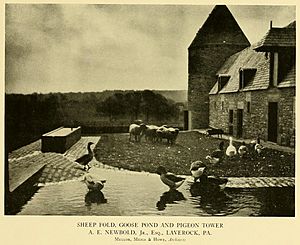Laverock, Pennsylvania facts for kids
Quick facts for kids
Laverock
|
|
|---|---|
|
Unincorporated community
Neighborhood of Cheltenham Township |
|
| Country | United States |
| State | Pennsylvania |
| County | Montgomery |
| Township | Cheltenham |
| Commissioner | Art Haywood |
| Elevation | 344 ft (105 m) |
| Time zone | UTC-5 (Eastern Standard Time) |
| • Summer (DST) | UTC-4 (Eastern Daylight Time) |
| ZIP Code |
19038
|
| Area codes | 215, 267 and 445 |
Laverock is a small community in Pennsylvania, United States. It's located in Montgomery County. Part of Laverock is in Cheltenham Township, and another part is in Springfield Township.
Laverock shares its ZIP code with Glenside, Pennsylvania. It is a close-by suburb of Philadelphia.
History of Laverock
In the late 1800s and early 1900s, many large mansions were built here. These homes were on big pieces of land. Not many new homes were built after 1929, when the Great Depression started. This was a time when many people lost their jobs and money.
The area stayed mostly undeveloped until after World War II. Today, Laverock is a neighborhood with only homes. It is known for its many large black oak trees.
Laverock Farm Estate
In 1895, a man named Arthur E. Newbold built a large house called "Farleigh." It was built in the Colonial-Revival style. This means it looked like older American colonial homes. His estate was on the north side of Willow Grove Avenue.
Later, his son, Arthur Jr., hired an architect named Arthur Ingersoll Meigs. Meigs was part of a famous architecture firm. Between 1919 and 1925, Meigs changed the mansion. He made it look like a Norman-Revival manor house. This style was inspired by old buildings from Normandy, France.
Meigs also created "Laverock Farm." This was a real working farm with beautiful buildings. These buildings mixed old and new styles. In 1925, "Laverock Farm" won a special award. It received the Gold Medal for Excellence in Design from the Architectural League of New York.
A famous writer named Lewis Mumford wrote about "Laverock Farm." He said that buildings like it were "architectural anaesthesia." He meant they helped people escape from their everyday lives. Mumford believed that buildings should instead help make the world better. He thought architecture should improve the world, not just be a way to escape it.
"Laverock Farm" only lasted about 30 years. It was torn down in 1956. A new neighborhood was built on the land. It had many split-level houses.




